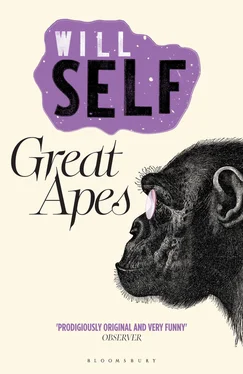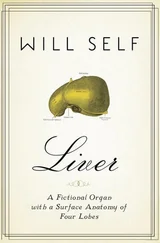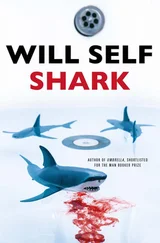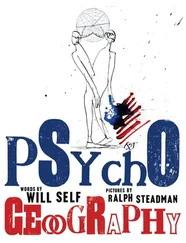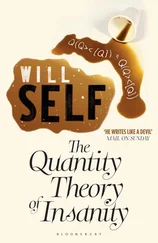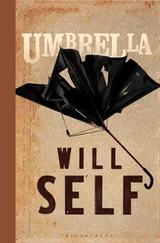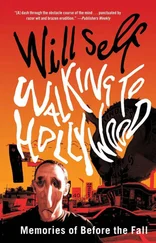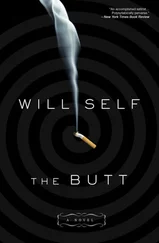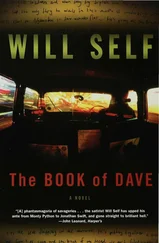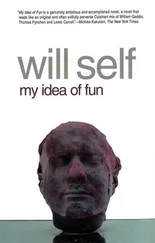The human body had — Simon felt — been pushed out over a purely local void, an overhang of time; it dangled there, a Navaho on a steel girder, pitting its head for heads against the sheer cliff of just-constructed, concretised techno. The wind had changed and left Simon’s human subjects distorted in the attitudes required to live in this world of terminal distressing. A crick had run through the Tower of Babylon, leaving language communities on all five hundred floors with wrenched shoulders and necks. This was what he wanted to express, but had the deregistration of his own body preceded, or followed from this? He could not tell.
At around the same time he had met Sarah. But he wasn’t sure that that was working, or that the working was working. All that he knew was that in the last year the days had got longer, had been filled with painting and the new people she introduced him to. That the hangovers had come, a hopeful sign because before — in the caesura, the and between Jean and — there had been no over, only hang. Further, that his children had in some way come back to him, felt comfortable with him once again. Sensed that the parasites eating him from within were, at least for the moment, sated.
Where was he? He was in Oxford Circus, standing outside Top Shop smoking an unfiltered Camel, looking across the arena of tar towards the reef of Regent Street, which curved away to the south. He was standing back from the pavement, against the plate-glass window. His temples thrummed and he felt claustrophobic as he envisioned the whole scene dumped upon by a giant ape. A post-imperial Kong who smashed the windows of the department stores and pulled out wriggling handfuls of humans, twined between his digits and caught like the termites they were in the cable-thick fur on the back of his huge hands. These people were finger food to the god, sushi for the divinity. He disentangled them from his fur, eyed their knotted faces, and then popped them between his teeth, each of which was the size of a dentist.
Mmmm…! Crunchy… and yet chewy. The clacking and gnashing of this car-park of a mouth filled the precincts, bio-noise greater than mechanical tumult. He paused, spat out a traffic warden whose reflective bandoleer had caught between his lower seven-and-eight. Inappropriate dental floss. He flexed his mighty arms, drummed on the roof of Hamley’s and let out a massive “HooooGraaa!”, which seemed to mean: I am body. I am the body. Sod the Father. Sod the Son, and piss on the Holy Ghost.
This pantagruelian pongid then paced around the block, kicking up cars like metallic divots, eating double-deckers as if they were Double Deckers, and then finally squatting in the very centre of the Circus itself to strain, push and deliver a turd the size of a newspaper kiosk, which wavered, lengthened from stub to cigar, before plummeting fifty feet from Kong’s arsehole on to the shaven heads of a posse of style-victim cycle couriers, who, like cattle in a thunderstorm, had taken shelter in the open.
Simon shook his head, the vision cleared, shaken into motes and flecks of humanity who scurried now at ground level. He checked his watch, saw that he was late, and turned in the direction of Sarah, to the Sealink.
Dr Zack Busnee, clinical psychologist, medical doctor, radical psychoanalyst, anti-psychiatrist, maverick anxiolytic drug researcher and former television personality, stood upright in front of the bathroom mirror teasing some crumbs from the thick fur under the line of his jaw. He’d had toast for his first breakfast that morning and, as usual, managed to get a fair amount of black cherry conserve into his coat instead of his stomach. He’d washed his fur thoroughly around the neck area — using the watercomb the Busners kept for just that purpose — but the crumbs obstinately refused to dissolve along with the jam. And the more he attempted to dig them out, the deeper into his fur they seemed to dig in.
No matter, he thought, turning his attention to dressing, Gambol can cope with it on the way into the hospital. Gambol, Busner’s research assistant, was waved upon to groom his boss a great deal. Of course, so were all the junior doctors, nurses and auxiliary workers at Heath Hospital, whether attached to the psychiatric department or not. Nowadays the more senior medical staff — and sometimes even administrators — would cluster around Busner as he swung into the hospital and attempt to get their fingers in his fur. If they couldn’t give him at least a cursory groom of deference, they would present to him and then scamper off about their business.
For, Busner, while a nonconformist and even zany psychiatric practitioner in youth and middle age, had on the cusp of old age begun to acquire something approaching respectability. The doctrinal excesses of the Quantity Theory of Insanity, with which he had been associated, fresh from his analytic training under the legendary Alkan, had long since been forgotten. The theory was now viewed — if chimps thought about it at all — as a piece of amusing wrongheadedness, a kind of socio-psychological version of Logical Positivism, or Marxism, or Freudianism. Obviously the predictions it had been designed to make had been disproved fulsomely, and yet, a second wave of apologists had sprung up to defend the theory, pointing out that the empirical verity of a hypothesis may not be the sole criterion on which to judge its significance.
Busner took the freshly ironed shirt from the hanger dangling on the back of the door and slipped it over his rounded shoulders. His fingers were still as nimble as ever. He fastened the buttons speedily, his thumbs managing to locate the knuckles of his index fingers to effect torsion, despite the arthritis that now plagued him. When he picked up his habitual mohair tie, looped it round his thick neck, knotted it, and folded down the collar, he was further reassured by the blur of motion in the mirror.
He left the collar unbuttoned and the tie knot slack — the better for Gambol to get at the crumbs. Meanwhile, one of his feet had, without any thought on his part, snatched a curry comb from the glass shelfunderneath the sink, and he now found himself absent-mindedly combing his muzzle while squinting at his own reflected features.
Pronounced eyebrow ridges with a light coping of silver-grey hairs, deeply recessed nasal bridge, neat, almond-shaped nostrils, no bagging of the muzzle, just a series of wriggling lines scored at oblique angles across the smooth skin of his full and froggy top lip. His lips were as moon-crescented and thinly generous as when he was young.
Not bad for a chimp nearing fifty, he mused, fluffing up into a halo the long tufts of grey fur surrounding his balding pate. No sign of goitre or mange, no ulcers either. At this rate I might make it to sixty! He thrust out his broad chest and flexed his long arms. While it’s true that in motion — which they almost always were — his features projected an impression of barely contained energy, in repose they slumped somewhat, slid into fleshly landslip, epidermal erosion. But Busner didn’t notice this. Distinguished, that’s what I am, he decided, and turned to remove a tweed jacket of uncommon tuftiness from a second hanger.
Busner’s return to the popular media role that he had filled with such assurance — some might say bumptiousness — while a young male had been tempered by maturity. In the previous five years he had published three books [1] The Chimp Who Mated an Armchair , 1986; Nestings , 1988; and A Primatologist Recounts , 1992. All published by Parallel Press, London and New York.
that had enormously augmented his reputation. While ostensibly collections of his patients’ case histories, they had performed the unusual feat of making quite difficult themes and theories in the fields of psychology and neurology accessible to a wide audience. Further, this had not been achieved by in any way trivialising. Busner prided himself on not condescending to his readers.
Читать дальше
